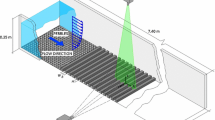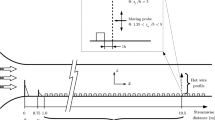Abstract
A two-dimensional numerical mesoscale model is used to determine the pressure drag of sinoidal mountains and valleys in a neutral atmosphere. In the first part, pressure distributions and flow patterns for isolated obstacles are considered. For large aspect ratios, the pressure drag exerted by valleys becomes small compared to that of mountains. In the second part, interactions between several obstacles are investigated. For mountains, the drag on downstream obstacles is reduced considerably by the first obstacle when the obstacles are close together. For valleys there is a slight increase of the average drag exerted by each obstacle. In the limit for a large number of obstacles, average drag exerted by one mountain is equal to average drag for one valley. For smaller aspect ratios, this average drag can be entered into the resistence law from the Rossby number similarity theory to yield an ‘effective roughness length’.
Similar content being viewed by others
References
Anthes, R. A. and Warner, T. T.: 1978, ‘Development of Hydrodynamic Models Suitable for Air Pollution and other Mesometeorological Studies’, Mon. Weather Rev. 106, 1045–1078.
Blackadar, A. K. and Tennekes, H.: 1968, ‘Asymptotic Similarity in Neutral Barotropic Planetary Boundary Layers’, J. Atm. Sci. 25, 1015–1020.
Clark, T. L. and Gall, R.: 1982, ‘Three-Dimensional Numerical Model Simulations of Airflow over Mountainous Terrain: A Comparison with Observations’, Mon. Weather Rev. 110, 766–791.
Davies, H. C. and Phillips, P. D.: 1985, ‘Mountain Drag along the Gotthard Section During Alpex’, J. Atm. Sci. 42, 2093–2109.
Dorwarth, G.: 1985, ‘Numerische Berechnung des Druckwiderstands typischer Geländeformen’, Dissertation, Institut für Meteorologie und Klimaforschung, Karlsruhe.
Fiedler, F. and Panofsky, H. A.: 1972, ‘The Geostrophic Drag Coefficient and the ‘Effective’ Roughness Length’, Quart. J. Roy. Meteorol. Soc. 98, 213–220.
Gross, G.: 1985, ‘An Explanation of the ‘Maloja-Serpent’ by Numerical Simulation’, Beitr. Phys. Atmosph. 58, 441–457.
Jackson, P. S. and Hunt, J. C. R.: 1975, ‘Turbulent Wind Flow over a Low Hill’, Quart. J. Roy. Meteorol. Soc. 101, 929–955.
Kustas, W. P. and Brutsaert, W.: 1986, ‘Wind Profile Constants in a Neutral Atmospheric Boundary Layer over Complex Terrain’, Boundary-Layer Meteorol. 34, 35–54.
Lettau, H.: 1969, ‘Note on Aerodynamic Roughness-Parameter Estimation on the Basis of Roughness-Element Description’, J. Appl. Meteorol. 8, 828–832.
Mahrer, Y. and Pielke, R. A.: 1978, ‘A Test of an Upstream Spline Interpolation Technique for the Advective Terms in a Numerical Mesoscale Model’, Mon. Weather Rev. 106, 1758.
Mason, P. J.: 1985, ‘On the Parameterization of Orographic Drag’, ECMWF-Seminar 1985, Vol.2, pp. 139–165.
Mason, P. J. and Sykes, R. I.: 1979a, ‘Separation Effects in Ekman Layer Flow over Ridges’, Quart. J. R. Meteorol. Soc. 105, 129–146.
Mason, P. J. and Sykes, R. I.: 1979b, ‘Flow over an Isolated Hill of Moderate Slope’, Quart. J. R. Meteorol. Soc. 105, 383–395.
Mellor, G. L. and Yamada, T.: 1982, ‘Development of a Turbulence Closure Model for Geophysical Fluid Problems’, Rev. Geoph. Space Phys. 20, 851–875.
Nappo, C. J., 1977: ‘Mesoscale Flow over Complex Terrain During the Eastern Tennessee Trajectory Experiment (ETTEX)’, J. Appl. Meteorol. 16, 1186–1196.
Newley, T. M. J.: 1985, ‘Turbulent Airflow over Hills’, Ph. D. Thesis, University of Cambridge, U.K.
Peltier, W. R. and Clark, T. L.: 1979, ‘The Evolution and Stability of Finite-Amplitude Mountain Waves Part II: Surface Wave Drag and Severe Downslope Windstorms’, J. Atm. Sci. 36, 1498–1529.
Pielke, R. A.: 1984, Mesoscale Meteorological Modelling, Academic Press, New York.
Taylor, P. A.: 1977, ‘Numerical Studies of Neutrally Stratified Planetary Boundary Layer Flow over Gentle Topography I: Two-Dimensional Cases’, Boundary-Layer Meteorol. 12, 37–60.
Taylor, P. A.: 1981, ‘Model Predictions of Neutrally Stratified Planetary Boundary Layer Flow over Ridges’, Quart. J. Roy. Meteorol. Soc. 107, 111–120.
Taylor, P. A. and Gent, P. R.: 1980, ‘Modification of the Boundary Layer by Orography’, GARP Publ. Series No. 23, pp. 143-165.
Thompson, R. S.: 1978, ‘Note on Aerodynamic Roughness Length for Complex Terrain’, J. Appl. Meteorol. 17, 1402–1403.
Walmsley, J. L., Salmon, J. R., and Taylor, P. A.: 1982, ‘On the Application of a Model of Boundary-Layer Flow over Low Hills to Real Terrain’, Boundary-Layer Meteorol. 23, 17–46.
Wippermann, F.: 1970, ‘The Two Constants in the Resistence Law for a Neutral Barotropic Boundary Layer of the Atmosphere’, Beitr. Phys. Atmosph. 43, 133–140.
Zeman, O. and Tennekes, H.: 1977, ‘Parameterization of the Turbulent Energy Budget at the Top of the Daytime Atmospheric Boundary Layer’, J. Atm. Sci. 34, 111–123.
Author information
Authors and Affiliations
Rights and permissions
About this article
Cite this article
Emeis, S. Pressure drag and effective roughness length with neutral stratification. Boundary-Layer Meteorol 39, 379–401 (1987). https://doi.org/10.1007/BF00125143
Accepted:
Issue Date:
DOI: https://doi.org/10.1007/BF00125143




